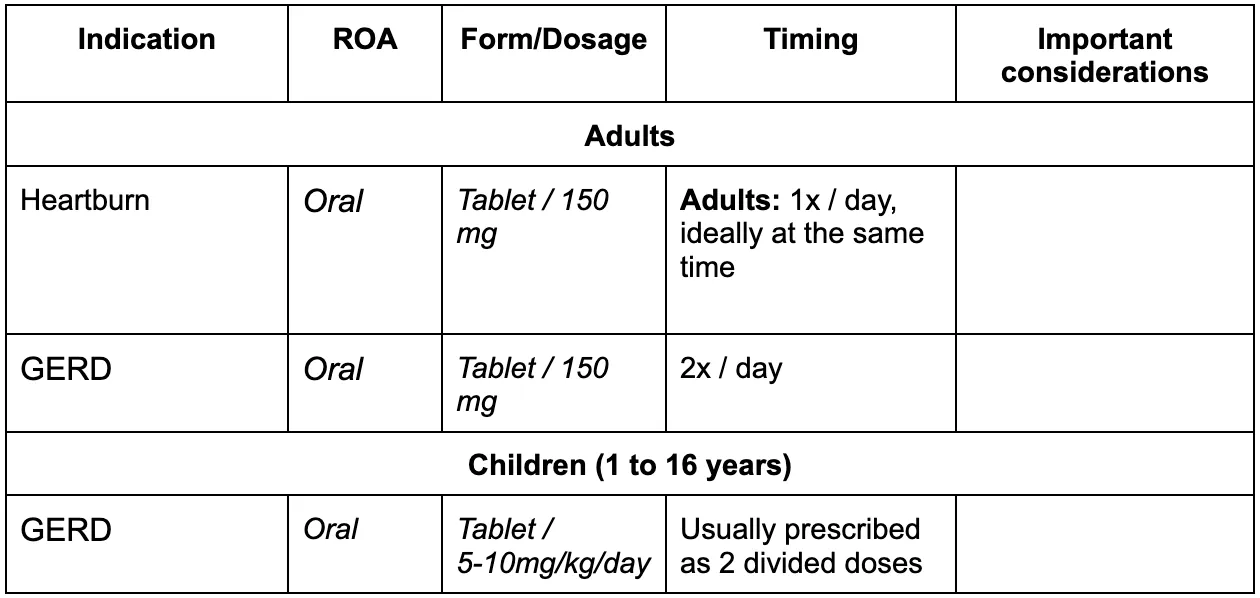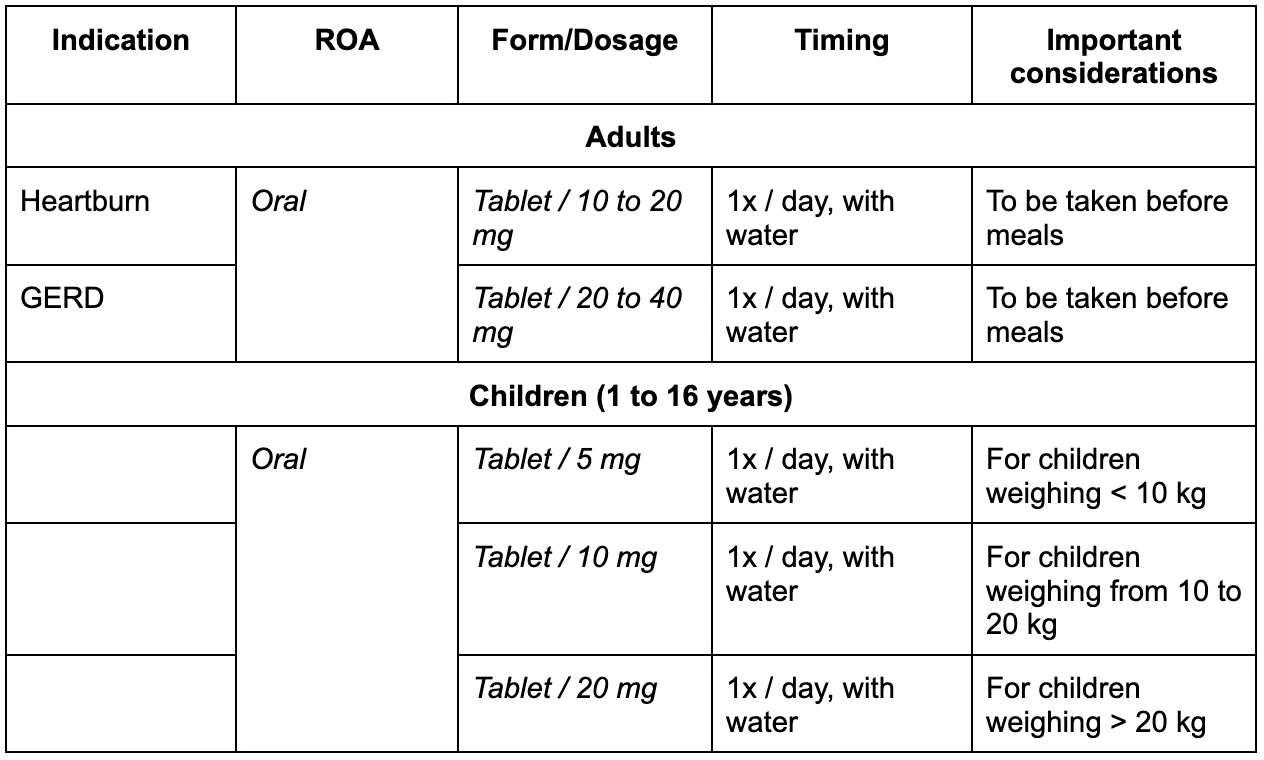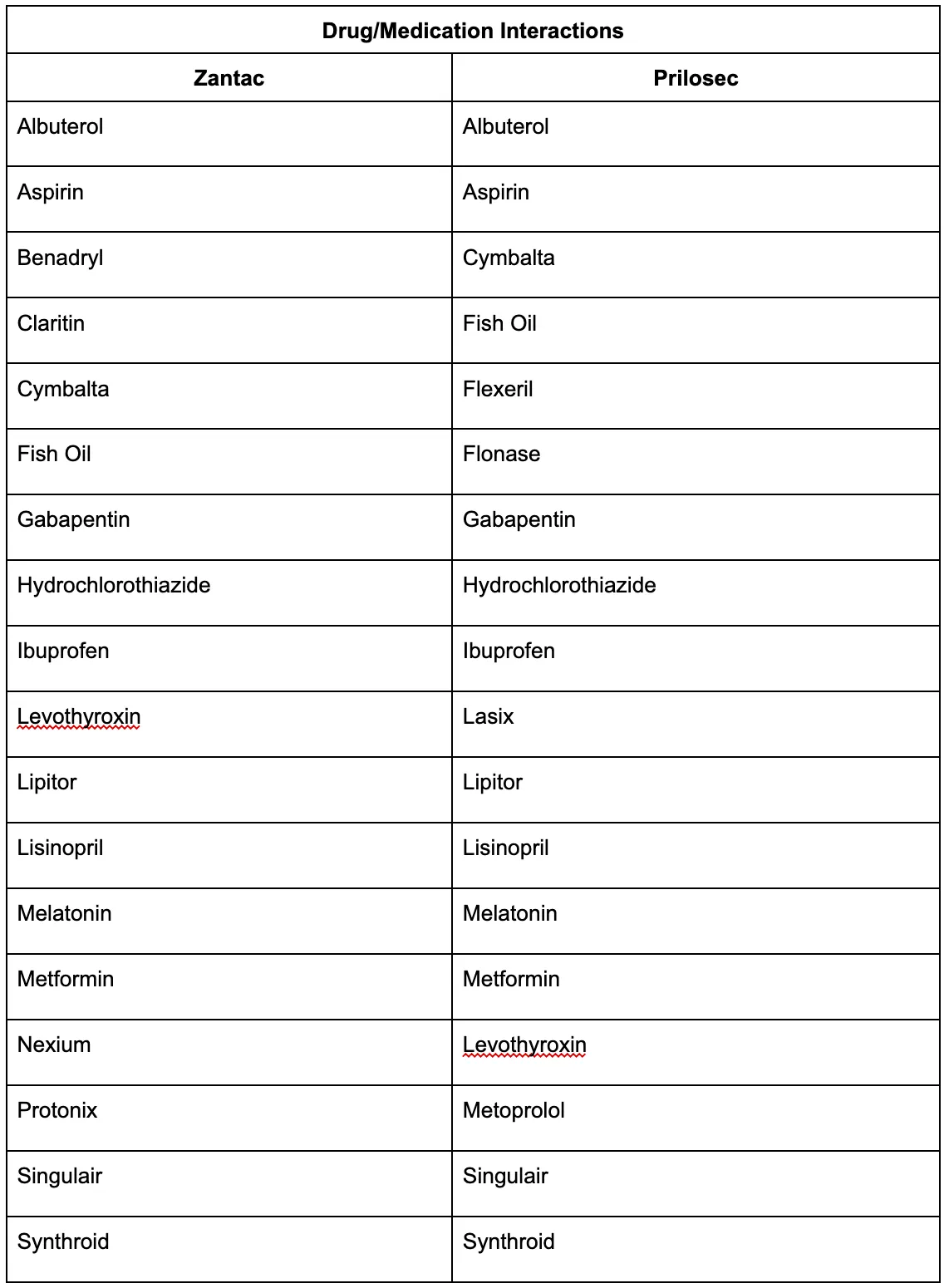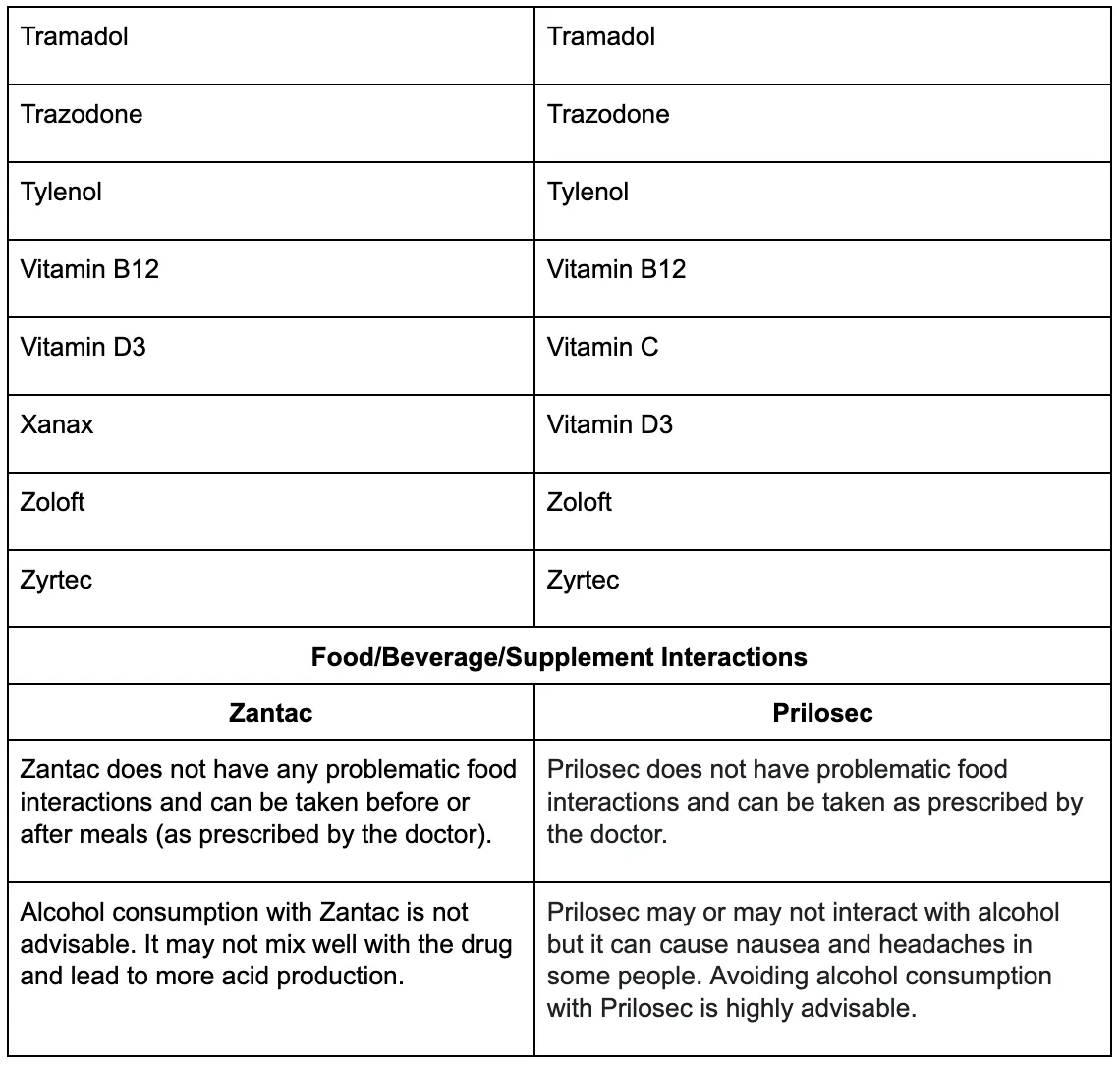Your session is about to expire
Zantac vs Prilosec
Introduction
Zantac and Prilosec are medicines used to treat heartburn caused by acid reflux. They reduce the acid production in the stomach to relieve heartburn. While both medications work on the same objective, their path of action is different. Prilosec represents the name of a generic drug, omeprazole which stops the action of pumps in the stomach to reduce acid production. On the other hand, Zantac represents a drug called famotidine. Zantac blocks histamine (a chemical in the body that supports the function of pumps) to reduce acid production. Both drugs are highly effective for most patients.[1]
About Zantac and Prilosec
What is Zantac?
Zantac is an acid-suppressing medication used to treat GERD, heartburn, and gastric ulcers. It is also effective against erosive esophagitis, duodenal ulcer prophylaxis, and other acid-related problems.[2] Drug manufacturers stopped the production of Zantac in 2020 due to the detection of a cancer-causing agent in ranitidine products. However, FDA approved the production of a new version of Zantac with famotidine.[3] Patients can use it in an injectable solution or in oral form. You can find it under different brand names in the market.
What conditions is Zantac approved to treat?
Zantac is suitable for patients with heartburn caused by acid reflux in the stomach. It can treat numerous gastric acid-related diseases effectively. The list includes the following.[4]
- Duodenal Ulcer
- Duodenal Ulcer Prophylaxis
- GERD
- Gastrointestinal Hemorrhage
- Indigestion
- Stress Ulcer Prophylaxis
- Zollinger-Elison Syndrome
How does Zantac work for heartburn?
Zantac (Famotidine) belongs to acid-blocking drugs known as H2 blockers. Famotidine in Zantac comes into action to block histamine. Blocking the chemical reduces the amount of acid in the stomach. Generally, the drug takes a minimum of 30 minutes to work. Moreover, it can control acid production in the stomach for up to 12 hours while minimizing the frequency of heartburn.[5]
What is Prilosec?
Prilosec is a Proton Pump Inhibitor (PPI) that decreases the production of acid in the stomach and promotes the healing of gastrointestinal problems. The drug is highly effective for inflamed gastrointestinal tissues. Doctors prescribe Prilosec to patients having Barrett’s esophagus, erosive esophagus, Gerd, indigestion, and other acid-induced diseases. Prilosec is widely available under different brand names. Patients can take Prilosec as an oral delayed-release capsule or oral delayed-release powder for reconstitution.[6]
What conditions is Prilosec approved to treat?
Prilosec (omeprazole) is a prescription medicine (as approved by FDA). It is an effective PPI for treating acid-related stomach problems by reducing the production of acid. The drug is approved to treat the following diseases.[7]
- Barret’s Esophagus
- Erosive Esophagus
- GERD
- Indigestion
- Duodenal Ulcer
- Helicobacter Pylori Infection
- Multiple Endocrine Adenomas
- Stomach Ulcer
- Systemic Mastocytosis
- Zollinger-Elison Syndrome
How does Prilosec work for heartburn?
Omeprazole is an effective medication to treat frequent heartburn and acid reflux. As a Proton Pump Inhibitor (PPI), omeprazole binds to the pumps producing acid in the stomach. They block the pumps to reduce acid production. As the acid settles down, the drug relieves heartburn. When prescribed with Prilosec, patients may expect the effects to take over after an hour. However, the omeprazole takes up to four days to complete effect.[8]
Effectiveness
How effective are Zantac and Prilosec for treating heartburn?
Zantac and Prilosec are effective drugs to treat a similar class of drugs. While both work on the same goals, Zantac causes relief earlier than Prilosec. While true, Zantac also wears off earlier than the effects of Prilosec. Prilosec takes up to a few days to fully come into effect.
Although both drugs are highly effective for GERD, their effectiveness varies. A comparison study of omeprazole and ranitidine highlighted the effectiveness of both drugs given to groups of patients. After eight weeks of treatment, 80% of patients were cured with a 20mg daily dose. On the contrary, the treatment was successful in 63% of patients who received 150mg of ranitidine twice (orally) daily.[9]
If we compare the effectiveness of both drugs individually, a study conducted to test the clinical effectiveness and quality of life with ranitidine compared with a placebo in a group of gastroesophageal reflux disease patients highlighted that taking ranitidine (150mg) twice daily is an effective therapy for GERD.[10] Another study compared the efficacy and safety of omeprazole given to groups of patients in varying doses. The results showed effective results in patients who received 20mg of omeprazole once daily to treat symptomatic GERD.[11]
Dosage Information
How is Zantac administered for heartburn?
Zantac dosage information


Side Effects
What are the most common side effects of Zantac?
Although Zantac is safe to use, it may have the following side effects in some patients:
- Headache
- Constipation
- Diarrhea
- Stomach Pain
- Vomiting
Please note that these are not all the possible side effects of Zantac. Sometimes, unfavorable drug interactions can lead to different effects.
Are there any potentially serious side effects of Zantac?
Generally, Zantac is well-tolerated, but in rare instances may lead to serious adverse effects. If you notice any of the following, you may immediately contact your doctor for help.[12]
- Allergic Reactions (rash, hives, itching, swollen/peeling/blistered skin)
- Wheezing
- Trouble Swallowing
- Swelling of the Mouth
- Dark Urine
- Lack of Appetite
What are the most common side effects of Prilosec?
The common side effects of Prilosec include the following:
- Stuffy Nose
- Sore Throat
- Fever (Especially in Children)
- Stomach Pain
- Nausea
- Diarrhea
- Vomiting
- Headache
Are there any potentially serious side effects of Prilosec?
Omeprazole is usually safe to use. However, some patients may face serious adverse effects from using the drug. If you notice any of the following symptoms, you may immediately seek your doctor’s help.[13]
- Allergic Reactions (hives, breathing problems, and swollen face, lips, throat, or tongue)
- Severe Pain in the Stomach
- Watery or Bloody Stools
- Unusual Pain in Back, Wrist, Thigh, or Hip
- Seizure
- Kidney Problems
- Symptoms of Lupus
Contraindications and Interactions
Warnings and general precautions for Zantac and Prilosec
Zantac and Prilosec may only be used during pregnancy if the benefit of the drug outweighs the risk to the fetus. According to US FDA, pregnancy category B details for Zantac, animal production studies did not highlight risk to the fetus. Moreover, there is a lack of well-controlled studies on pregnant women to validate the data.[14] On the other hand, animal models with Prilosec doses indicated increased embryo lethality and pregnancy disruptions during organogenesis.[15]
To ensure safe results, you may thoroughly understand the complications and possible side effects of each medication before use. Seeking your doctor’s help can be effective in this regard.
Contraindications and important interactions for Zantac and Prilosec



Cost Comparison
How much do Zantac and Prilosec cost?
If we compare the costs of Zantac and Prilosec, a 150mg capsule (oral) may cost $1.09 and (approximately) $65.66 for 60 capsules. The cost of a 300mg capsule is $1.51, while 30 capsules may cost you (approximately) $45.32.[16] On the other hand, a 20mg capsule of Prilosec may cost $1.43. You may get a pack of 14 capsules for (approximately) $20.07.[17]
The average cost of Zantac per prescription is $30.32, and $0.32 per day of drug therapy. On the contrary, the average cost per prescription of Prilosec is $16.18, and $0.32 per day of drug therapy.
Popularity of Zantac and Prilosec
Zantac and Prilosec are widely popular for the treatment of GERD. However, Prilosec holds a consistent rank among the top drugs in the U.S. (based on 2013-2020 data) and ranks in the 8th spot. Zantac, on the other hand, has mixed popularity and ranks 177th on the list of the top drugs in the country.
Conclusion
Takeaway
Zantac and Prilosec are used to treat a similar class of diseases. Both drugs are effective in treating GERD and other gastric acid-induced diseases. Despite their similar objective, Zantac reduces acid production in the stomach by blocking histamine, while Prilosec does it by blocking the acid pumps. Although Prilosec is found to be more effective, both drugs have sufficient evidence to support effective outcomes in GERD patients.